INTERNATIONAL
STANDARD
ISO/IEC
29100
First edition
2011-12-15
Information technology — Security
techniques — Privacy framework
Technologies de l'information — Techniques de sécurité — Cadre privé
Reference number
ISO/IEC 29100:2011(E)
© ISO/IEC 2011
�
ISO/IEC 29100:2011(E)
COPYRIGHT PROTECTED DOCUMENT
© ISO/IEC 2011
All rights reserved. Unless otherwise specified, no part of this publication may be reproduced or utilized in any form or by any means,
electronic or mechanical, including photocopying and microfilm, without permission in writing from either ISO at the address below or
ISO's member body in the country of the requester.
ISO copyright office
Case postale 56 CH-1211 Geneva 20
Tel. + 41 22 749 01 11
Fax + 41 22 749 09 47
E-mail copyright@iso.org
Web www.iso.org
Published in Switzerland
ii
© ISO/IEC 2011 – All rights reserved
�
ISO/IEC 29100:2011(E)
Contents
Page
Foreword ............................................................................................................................................................. v
Introduction ........................................................................................................................................................ vi
Scope ...................................................................................................................................................... 1
1
2
Terms and definitions ........................................................................................................................... 1
Symbols and abbreviated terms .......................................................................................................... 4
3
Basic elements of the privacy framework ........................................................................................... 5
4
4.1
Overview of the privacy framework ..................................................................................................... 5
4.2
Actors and roles .................................................................................................................................... 5
4.2.1 PII principals .......................................................................................................................................... 5
4.2.2 PII controllers ......................................................................................................................................... 5
4.2.3 PII processors ........................................................................................................................................ 5
4.2.4 Third parties ........................................................................................................................................... 6
Interactions ............................................................................................................................................ 6
4.3
Recognizing PII ...................................................................................................................................... 7
4.4
4.4.1
Identifiers ............................................................................................................................................... 7
4.4.2 Other distinguishing characteristics ................................................................................................... 7
4.4.3
Information which is or might be linked to a PII principal ................................................................ 8
4.4.4 Pseudonymous data ............................................................................................................................. 9
4.4.5 Metadata ................................................................................................................................................. 9
4.4.6 Unsolicited PII ........................................................................................................................................ 9
4.4.7 Sensitive PII ........................................................................................................................................... 9
4.5
Privacy safeguarding requirements .................................................................................................. 10
4.5.1 Legal and regulatory factors .............................................................................................................. 11
4.5.2 Contractual factors .............................................................................................................................. 11
4.5.3 Business factors .................................................................................................................................. 12
4.5.4 Other factors ........................................................................................................................................ 12
Privacy policies ................................................................................................................................... 13
4.6
Privacy controls ................................................................................................................................... 13
4.7
5
The privacy principles of ISO/IEC 29100 ........................................................................................... 14
Overview of privacy principles .......................................................................................................... 14
5.1
Consent and choice ............................................................................................................................ 14
5.2
Purpose legitimacy and specification ............................................................................................... 15
5.3
5.4
Collection limitation ............................................................................................................................ 15
Data minimization ................................................................................................................................ 16
5.5
Use, retention and disclosure limitation ........................................................................................... 16
5.6
Accuracy and quality .......................................................................................................................... 16
5.7
5.8
Openness, transparency and notice ................................................................................................. 17
5.9
Individual participation and access ................................................................................................... 17
5.10 Accountability ...................................................................................................................................... 18
Information security ............................................................................................................................ 18
5.11
5.12
Privacy compliance ............................................................................................................................. 19
Annex A (informative) Correspondence between ISO/IEC 29100 concepts and ISO/IEC 27000
concepts ............................................................................................................................................... 20
Bibliography ...................................................................................................................................................... 21
© ISO/IEC 2011 – All rights reserved
iii
�
ISO/IEC 29100:2011(E)
Figures
Figure 1 – Factors influencing privacy risk management .................................................................................. 11
Tables
Table 1 – Possible flows of PII among the PII principal, PII controller, PII processor and a third party and their
7
roles
Table 2 – Example of attributes that can be used to identify natural persons
Table 3 – The privacy principles of ISO/IEC 29100
Table A.1 – Matching ISO/IEC 29100 concepts to ISO/IEC 27000 concepts
8
14
20
iv
© ISO/IEC 2011 – All rights reserved
�
ISO/IEC 29100:2011(E)
Foreword
ISO (the International Organization for Standardization) and IEC (the International Electrotechnical
Commission) form the specialized system for worldwide standardization. National bodies that are members of
ISO or IEC participate in the development of International Standards through technical committees
established by the respective organization to deal with particular fields of technical activity. ISO and IEC
technical committees collaborate in fields of mutual interest. Other international organizations, governmental
and non-governmental, in liaison with ISO and IEC, also take part in the work. In the field of information
technology, ISO and IEC have established a joint technical committee, ISO/IEC JTC 1.
International Standards are drafted in accordance with the rules given in the ISO/IEC Directives, Part 2.
The main task of the joint technical committee is to prepare International Standards. Draft International
Standards adopted by the joint technical committee are circulated to national bodies for voting. Publication as
an International Standard requires approval by at least 75 % of the national bodies casting a vote.
Attention is drawn to the possibility that some of the elements of this document may be the subject of patent
rights. ISO and IEC shall not be held responsible for identifying any or all such patent rights.
ISO/IEC 29100 was prepared by Joint Technical Committee ISO/IEC JTC 1, Information technology,
Subcommittee SC 27, IT Security techniques.
© ISO/IEC 2011 – All rights reserved
v
�
ISO/IEC 29100:2011(E)
Introduction
This International Standard provides a high-level framework for the protection of personally
identifiable information (PII) within information and communication technology (ICT) systems. It is
general in nature and places organizational, technical, and procedural aspects in an overall privacy
framework.
The privacy
requirements related to PII within an ICT environment by:
framework
is
intended
to help organizations define
their privacy safeguarding
-
-
-
-
specifying a common privacy terminology;
defining the actors and their roles in processing PII;
describing privacy safeguarding requirements; and
referencing known privacy principles.
In some jurisdictions, this International Standard’s references to privacy safeguarding requirements
might be understood as being complementary to legal requirements for the protection of PII. Due to
the increasing number of information and communication technologies that process PII, it is
important to have international information security standards that provide a common understanding
for the protection of PII. This International Standard is intended to enhance existing security
standards by adding a focus relevant to the processing of PII.
The increasing commercial use and value of PII, the sharing of PII across legal jurisdictions, and the
growing complexity of ICT systems, can make it difficult for an organization to ensure privacy and to
achieve compliance with the various applicable laws. Privacy stakeholders can prevent uncertainty
and distrust from arising by handling privacy matters properly and avoiding cases of PII misuse.
Use of this International Standard will:
-
-
-
aid in the design, implementation, operation, and maintenance of ICT systems that handle and protect
PII;
spur innovative solutions to enable the protection of PII within ICT systems; and
improve organizations’ privacy programs through the use of best practices.
The privacy framework provided within this International Standard can serve as a basis for additional
privacy standardization initiatives, such as for:
-
-
-
-
-
a technical reference architecture;
the implementation and use of specific privacy technologies and overall privacy management;
privacy controls for outsourced data processes;
privacy risk assessments; or
specific engineering specifications.
Some jurisdictions might require compliance with one or more of the documents referenced in
ISO/IEC JTC 1/SC 27 WG 5 Standing Document 2 (WG 5 SD2) — Official Privacy Documents
References [3] or with other applicable laws and regulations, but this International Standard is not
intended to be a global model policy, nor a legislative framework.
vi
© ISO/IEC 2011 – All rights reserved
�
INTERNATIONAL STANDARD
ISO/IEC 29100:2011(E)
Information technology — Security techniques — Privacy
framework
1 Scope
This International Standard provides a privacy framework which
-
-
-
-
specifies a common privacy terminology;
defines the actors and their roles in processing personally identifiable information (PII);
describes privacy safeguarding considerations; and
provides references to known privacy principles for information technology.
This International Standard is applicable to natural persons and organizations involved in specifying,
procuring, architecting, designing, developing, testing, maintaining, administering, and operating
information and communication technology systems or services where privacy controls are required
for the processing of PII.
2 Terms and definitions
For the purposes of this document, the following terms and definitions apply.
NOTE
In order to make it easier to use the ISO/IEC 27000 family of International Standards in the specific context of
privacy and to integrate privacy concepts in the ISO/IEC 27000 context, the table in Annex A provides the ISO/IEC 27000
concepts that correspond with the ISO/IEC 29100 concepts used in this International Standard.
2.1
anonymity
characteristic of information that does not permit a personally identifiable information principal to be
identified directly or indirectly
2.2
anonymization
process by which personally identifiable information (PII) is irreversibly altered in such a way that a
PII principal can no longer be identified directly or indirectly, either by the PII controller alone or in
collaboration with any other party
2.3
anonymized data
data that has been produced as the output of a personally identifiable information anonymization
process
2.4
consent
personally identifiable information (PII) principal’s freely given, specific and informed agreement to
the processing of their PII
© ISO/IEC 2011 – All rights reserved
1
�
ISO/IEC 29100:2011(E)
2.5
identifiability
condition which results in a personally identifiable information (PII) principal being identified, directly
or indirectly, on the basis of a given set of PII
2.6
identify
establish the link between a personally identifiable information (PII) principal and PII or a set of PII
2.7
identity
set of attributes which make it possible to identify the personally identifiable information principal
2.8
opt-in
process or type of policy whereby the personally identifiable information (PII) principal is required to
take an action to express explicit, prior consent for their PII to be processed for a particular purpose
NOTE
A different term that is often used with the privacy principle ‘consent and choice’ is “opt-out”. It describes a
process or type of policy whereby the PII principal is required to take a separate action in order to withhold or withdraw
consent, or oppose a specific type of processing. The use of an opt-out policy presumes that the PII controller has the right
to process the PII in the intended way. This right can be implied by some action of the PII principal different from consent
(e.g., placing an order in an online shop).
2.9
personally identifiable information
PII
any information that (a) can be used to identify the PII principal to whom such information relates, or
(b) is or might be directly or indirectly linked to a PII principal
NOTE
reasonably be used by the privacy stakeholder holding the data, or by any other party, to identify that natural person.
To determine whether a PII principal is identifiable, account should be taken of all the means which can
2.10
PII controller
privacy stakeholder (or privacy stakeholders) that determines the purposes and means for
processing personally identifiable information (PII) other than natural persons who use data for
personal purposes
NOTE
responsibility for the processing remains with the PII controller.
A PII controller sometimes instructs others (e.g., PII processors) to process PII on its behalf while the
2.11
PII principal
natural person to whom the personally identifiable information (PII) relates
NOTE
subject” can also be used instead of the term “PII principal”.
Depending on the jurisdiction and the particular data protection and privacy legislation, the synonym “data
2.12
PII processor
privacy stakeholder that processes personally identifiable information (PII) on behalf of and in
accordance with the instructions of a PII controller
2.13
privacy breach
situation where personally identifiable information is processed in violation of one or more relevant
privacy safeguarding requirements
2
© ISO/IEC 2011 – All rights reserved
�
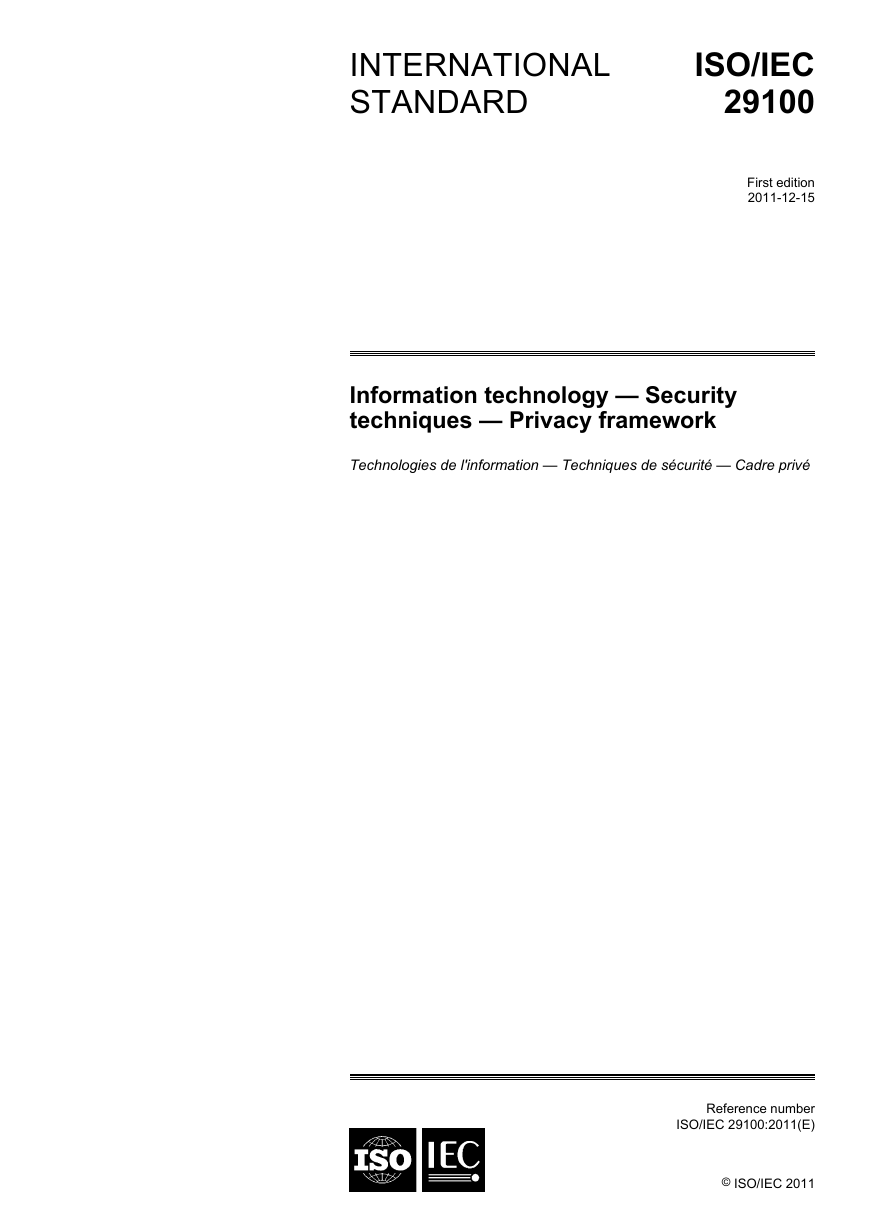
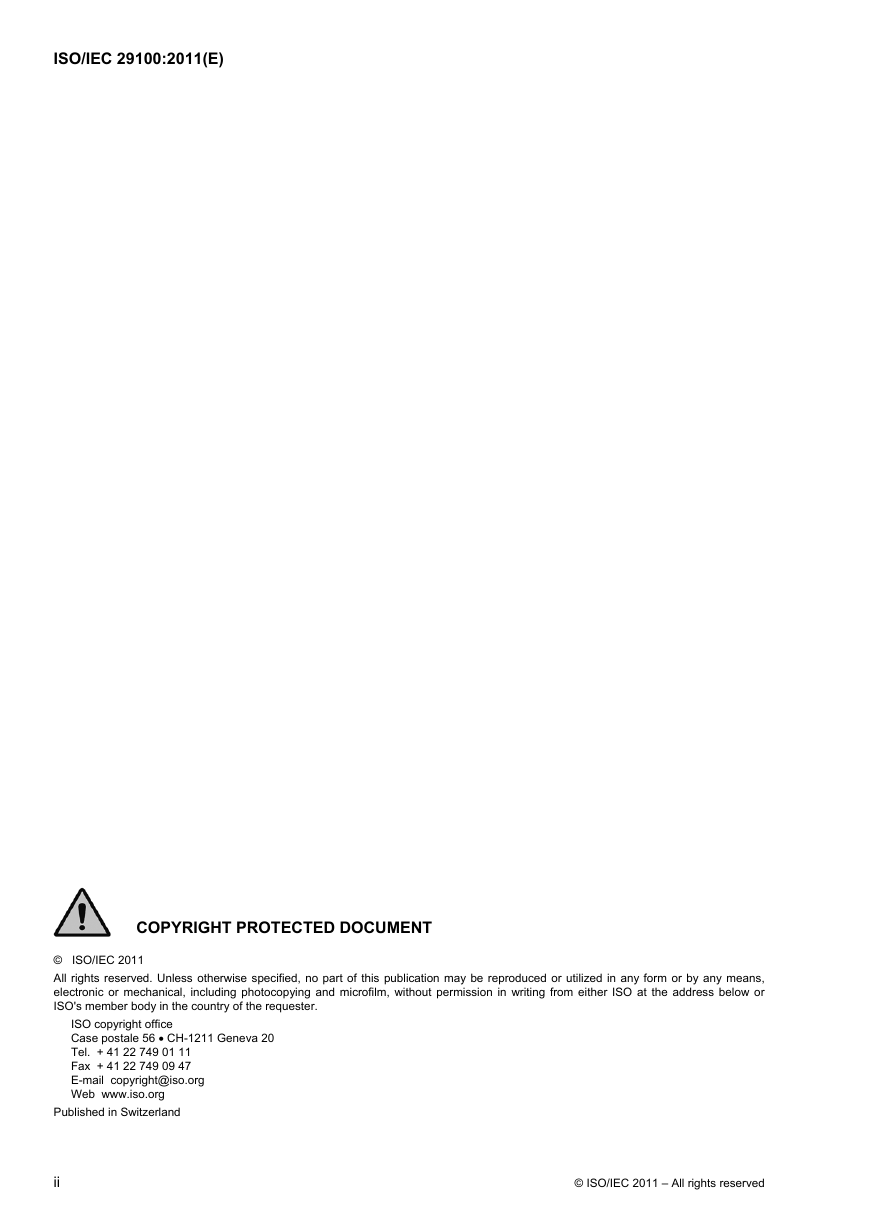
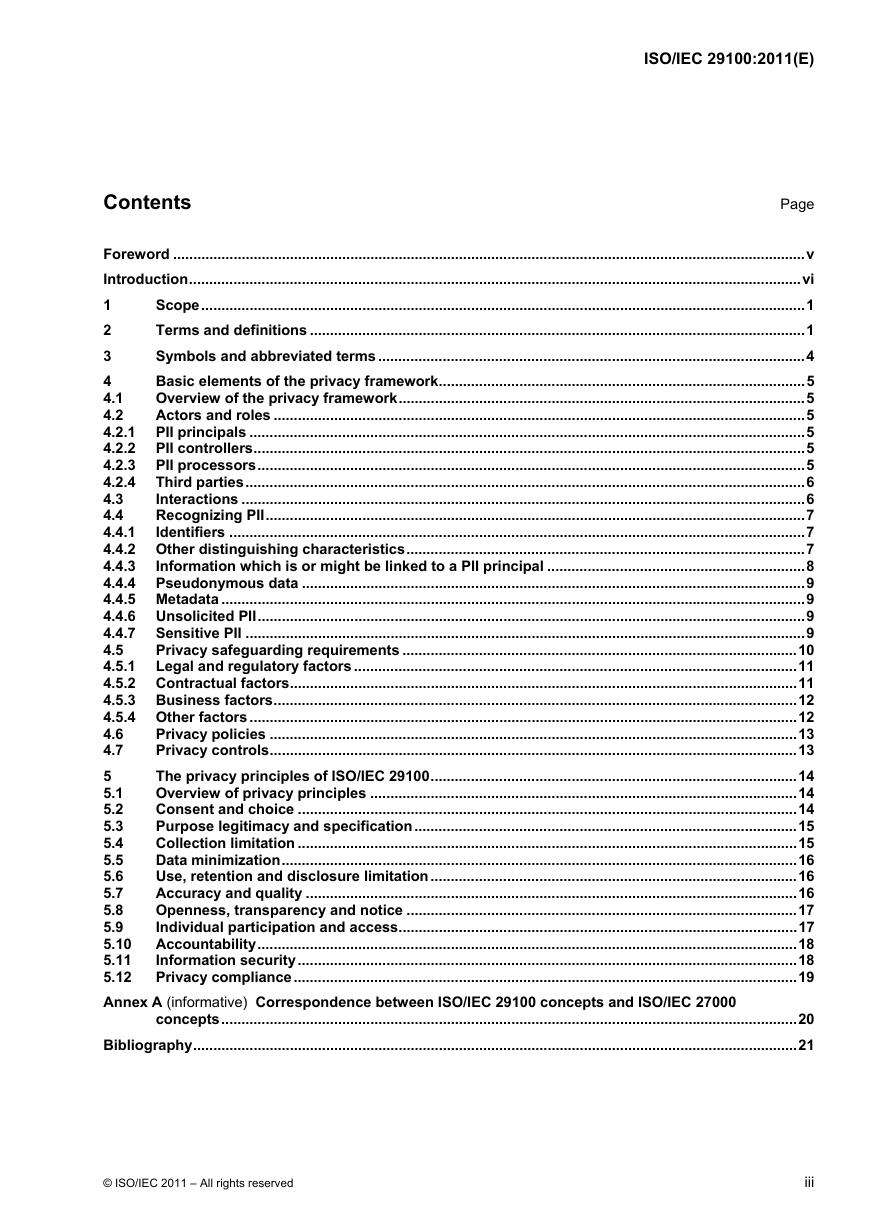
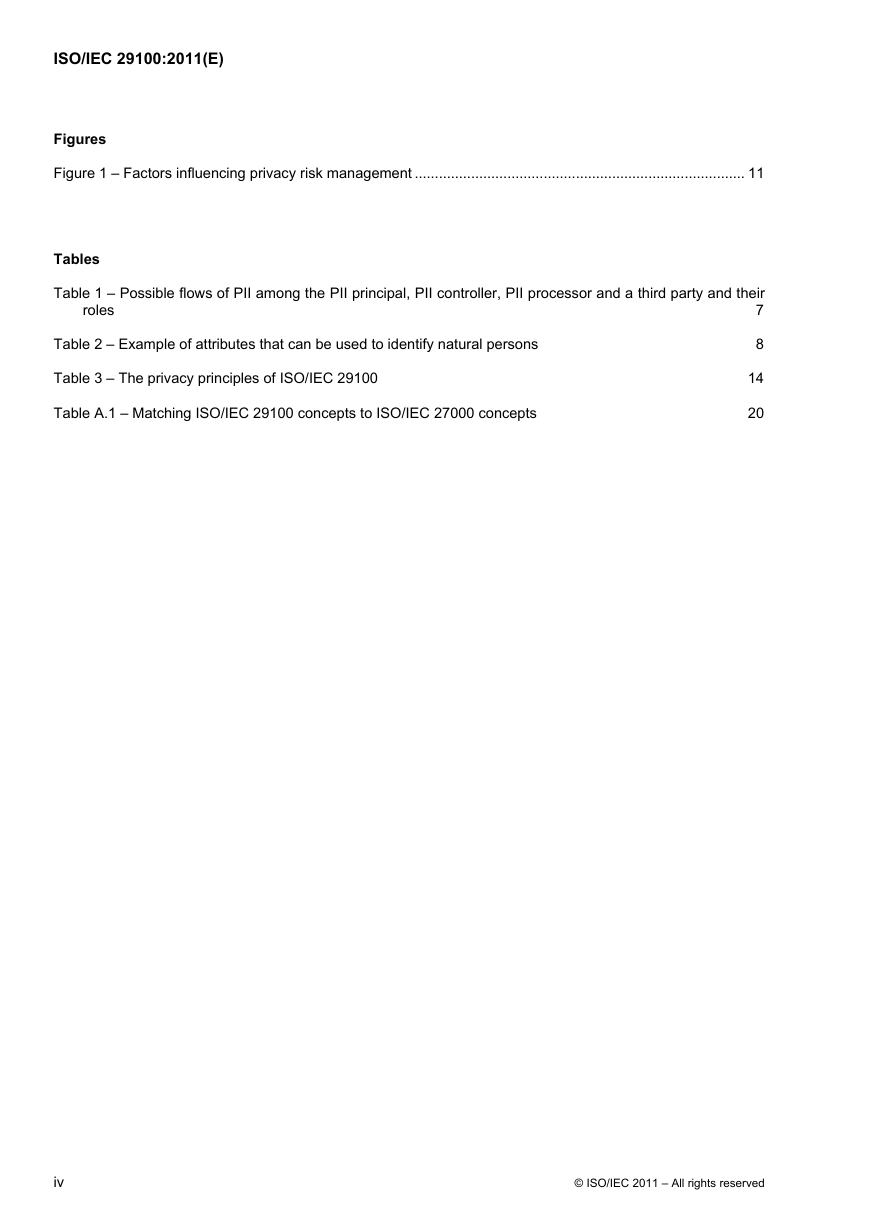
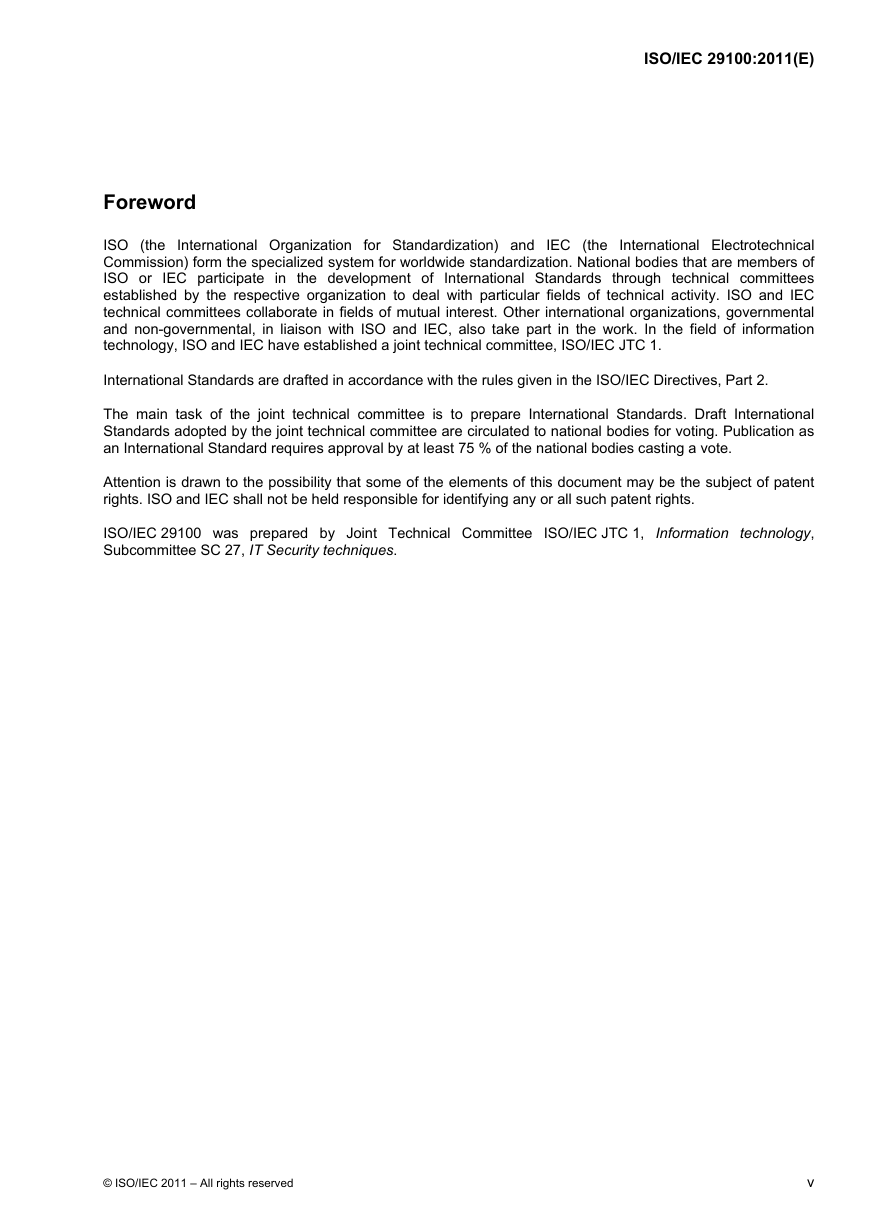


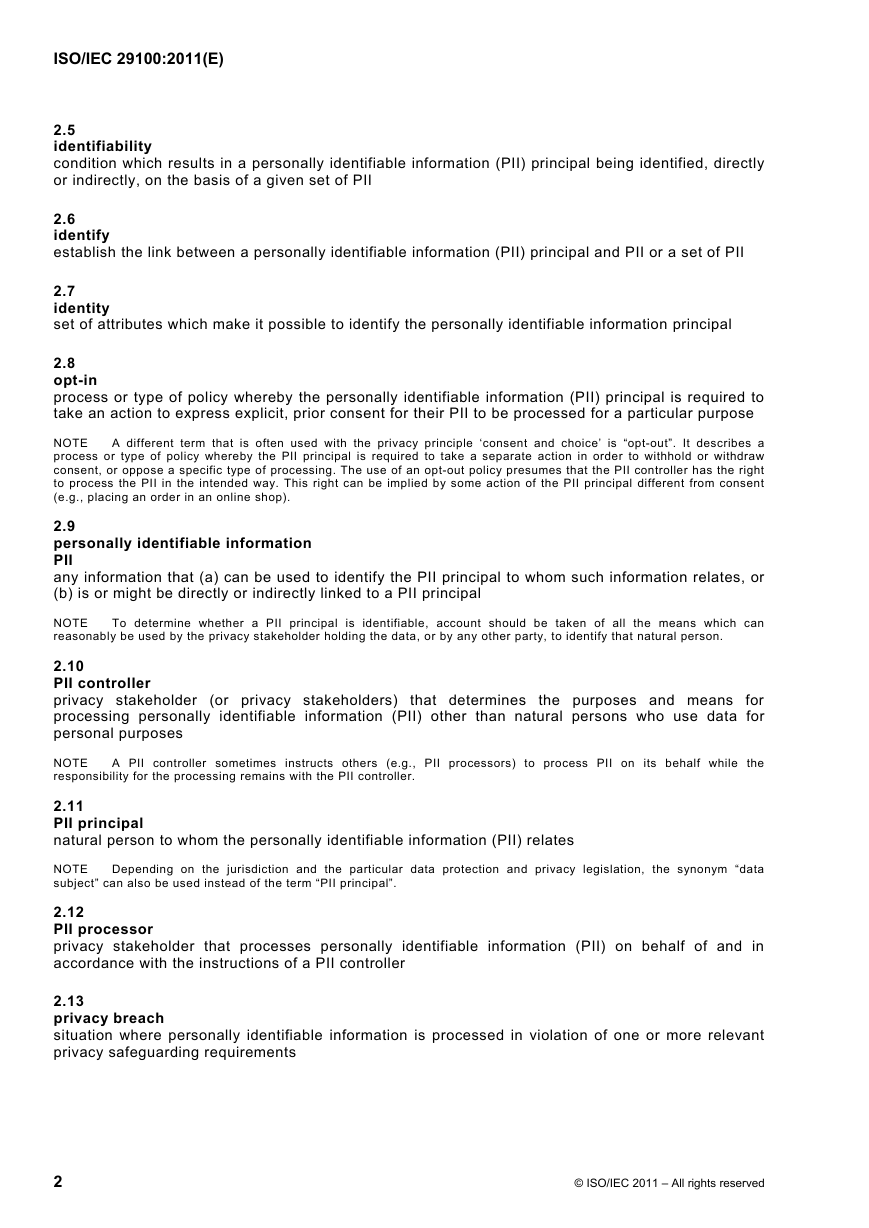








 2023年江西萍乡中考道德与法治真题及答案.doc
2023年江西萍乡中考道德与法治真题及答案.doc 2012年重庆南川中考生物真题及答案.doc
2012年重庆南川中考生物真题及答案.doc 2013年江西师范大学地理学综合及文艺理论基础考研真题.doc
2013年江西师范大学地理学综合及文艺理论基础考研真题.doc 2020年四川甘孜小升初语文真题及答案I卷.doc
2020年四川甘孜小升初语文真题及答案I卷.doc 2020年注册岩土工程师专业基础考试真题及答案.doc
2020年注册岩土工程师专业基础考试真题及答案.doc 2023-2024学年福建省厦门市九年级上学期数学月考试题及答案.doc
2023-2024学年福建省厦门市九年级上学期数学月考试题及答案.doc 2021-2022学年辽宁省沈阳市大东区九年级上学期语文期末试题及答案.doc
2021-2022学年辽宁省沈阳市大东区九年级上学期语文期末试题及答案.doc 2022-2023学年北京东城区初三第一学期物理期末试卷及答案.doc
2022-2023学年北京东城区初三第一学期物理期末试卷及答案.doc 2018上半年江西教师资格初中地理学科知识与教学能力真题及答案.doc
2018上半年江西教师资格初中地理学科知识与教学能力真题及答案.doc 2012年河北国家公务员申论考试真题及答案-省级.doc
2012年河北国家公务员申论考试真题及答案-省级.doc 2020-2021学年江苏省扬州市江都区邵樊片九年级上学期数学第一次质量检测试题及答案.doc
2020-2021学年江苏省扬州市江都区邵樊片九年级上学期数学第一次质量检测试题及答案.doc 2022下半年黑龙江教师资格证中学综合素质真题及答案.doc
2022下半年黑龙江教师资格证中学综合素质真题及答案.doc